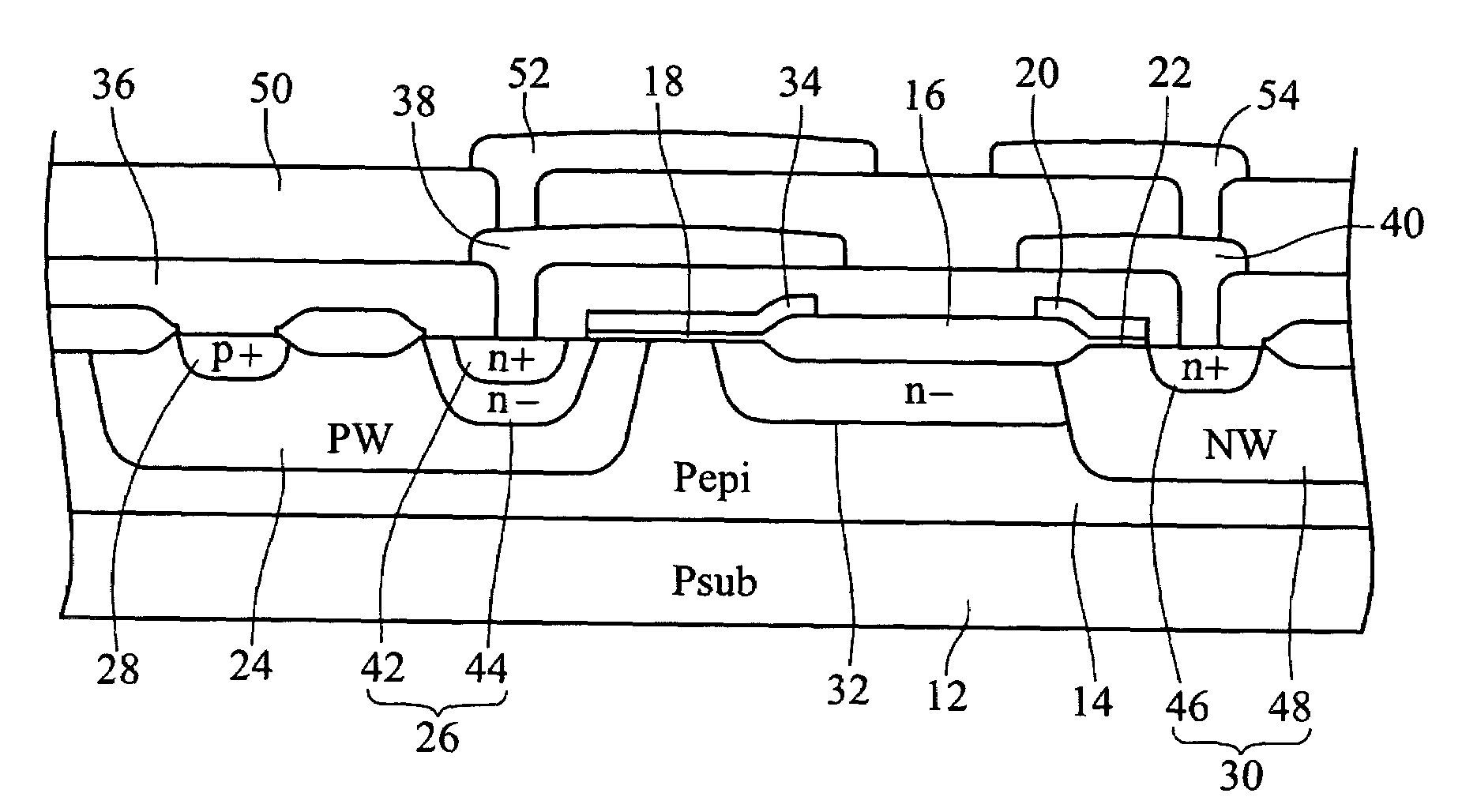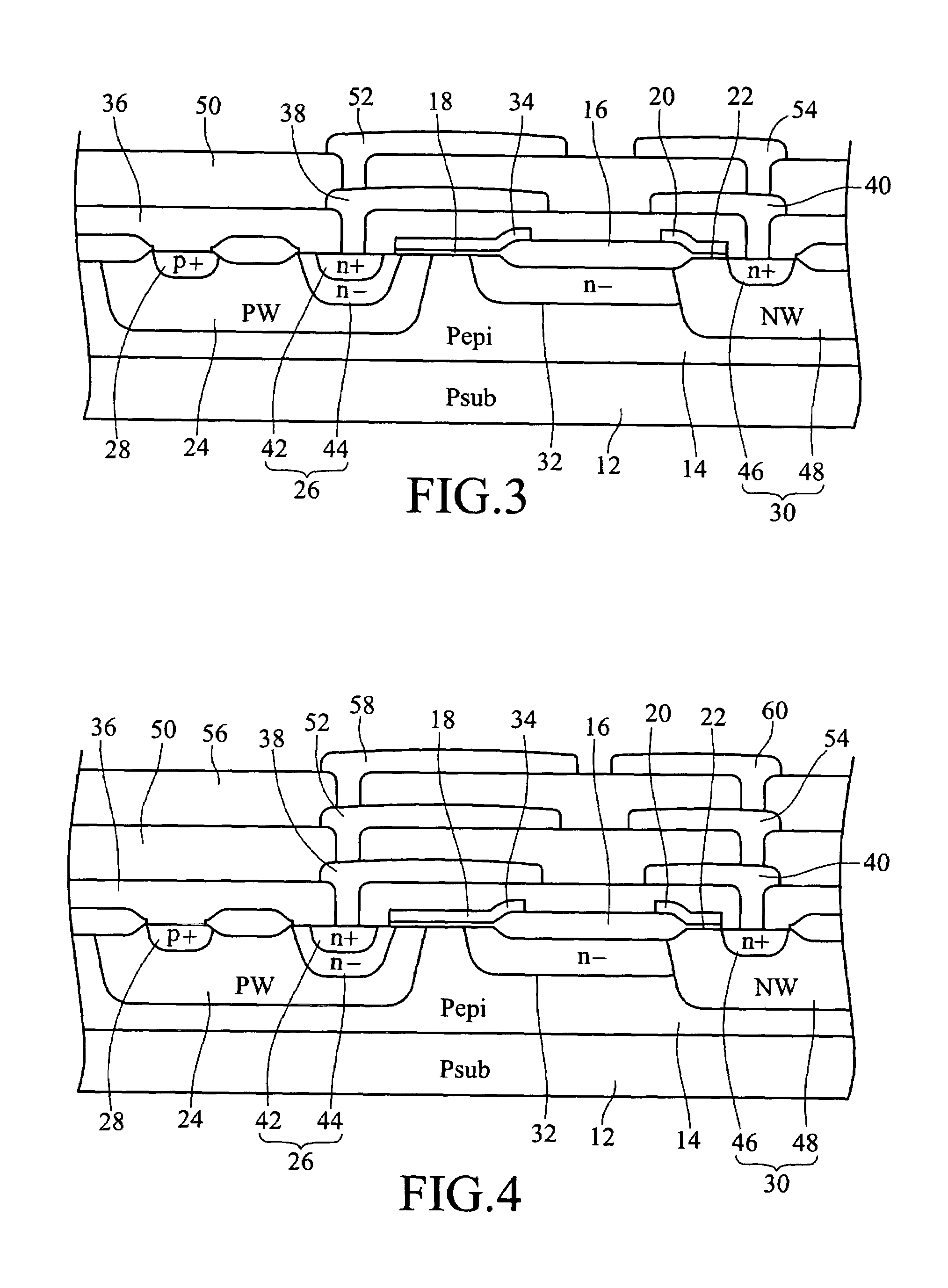High voltage laterally double-diffused metal oxide semiconductor
a metal oxide semiconductor, laterally doubled technology, applied in semiconductor devices, semiconductor/solid-state device details, electrical apparatus, etc., can solve the problem that its breakdown voltage is often not capable of meeting actual requirements, and achieves low resistance, high breakdown voltage, and reduced field concentration
- Summary
- Abstract
- Description
- Claims
- Application Information
AI Technical Summary
Benefits of technology
Problems solved by technology
Method used
Image
Examples
second embodiment
[0040]The second embodiment further includes the third drain electrode metal layer 60 connected to the second drain metal layer 54, extending laterally on the third insulation layer 56 in the direction towards the gate electrode 34, with its length protruding out of the edge of the second drain electrode metal layer 54, and further overlapping more portions of the drift layer 32 than the second drain electrode metal layer 52.
[0041]The LDMOS structure shown in FIG. 4 is only provided with one more metal layer than that as shown in FIG. 3. Besides, their manufacturing processes are similar; therefore, it will not be repeated here for brevity's sake.
[0042]In the above-mentioned LDMOS structure, though each source electrode metal layer and each drain electrode metal layer extend towards each other, yet they do not touch each other. Namely, each source electrode metal layer and drain electrode metal layer have their preferable extension length. For example, the preferred extension length...
third embodiment
[0053]Please refer to FIG. 7, which shows the LDMOS structure defined by the source electrode region variations according to the invention.
[0054]As shown in FIG. 7, except for the source electrode region, the other elements such as the drain electrode region of the LDMOS structure are similar to those as shown in FIGS. 3 and 4, as such they will not be repeated here for brevity's sake. In addition, similar numerals are utilized for the elements similar to those as shown in the previous drawings.
[0055]The above-mentioned LDMOS structure is formed in the P-type epitaxy layer 14, located on the P-type substrate 12.
[0056]The characteristics of this particular LDMOS structure are: the said p+ region 28 is located in the P well 24, which is adjacent to the N source electrode region 26; in addition, the said N source electrode region 26 may include a n+ region 42 extending downwards from the surface of the said P-type epitaxy layer 14, and an N well 62 encircling the said n+ region 42.
fourth embodiment
[0057]Please refer to FIG. 8, which shows the LDMOS structure defined by the source electrode variations according to the invention.
[0058]As shown in FIG. 8, except for the source electrode region, the other elements, such as the drain electrode region of the LDMOS structure, are similar to those as shown in FIGS. 3 and 4. As such, they will not be repeated here for brevity's sake. In addition, similar numerals are utilized for the elements similar to those as shown in the previous drawings.
[0059]The above-mentioned LDMOS structure is formed in the P-type epitaxy layer, 14 located on the P-type substrate 12.
[0060]The characteristics of this particular LDMOS structure are: the said LDMOS structure includes two P wells 24,64 and an N source electrode region 26 located in the epitaxy layer 14; wherein the two P wells 24,64 are closely adjacent to the two sides of the said N source electrode region 26; the p+ region 28 is located in a P well 24 closely adjacent to the outer side of the ...
PUM
 Login to View More
Login to View More Abstract
Description
Claims
Application Information
 Login to View More
Login to View More - R&D
- Intellectual Property
- Life Sciences
- Materials
- Tech Scout
- Unparalleled Data Quality
- Higher Quality Content
- 60% Fewer Hallucinations
Browse by: Latest US Patents, China's latest patents, Technical Efficacy Thesaurus, Application Domain, Technology Topic, Popular Technical Reports.
© 2025 PatSnap. All rights reserved.Legal|Privacy policy|Modern Slavery Act Transparency Statement|Sitemap|About US| Contact US: help@patsnap.com



